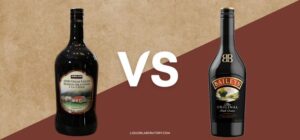Ardbeg and Laphroaig are known for their incredibly rich and complex peated Scotch whiskies.
Located on the Isle of Islay, Laphroaig and Ardbeg have unique characteristics. But which of these two Islay whiskies will win your heart?
In this in-depth comparison, we’ll discuss the various differences between Laphroaig vs Ardbeg to see which spirit deserves your recognition. Read on.
Table of Contents
ToggleComparing Laphroaig vs Ardbeg Peated Scotch Whiskies

Specifically, Ardbeg 10 has 46% ABV, a smooth and refreshing blend you can enjoy alone, while the Laphroaig 10 has a higher ABV of 58.6%, which is best mixed with water.
On the palate, Ardbeg 10 is a bit more herbal and grassy with mellow mint and rosemary than the Laphroaig 10, which is known for its medicinal peat (iodine and bandaid).
The finish of Ardbeg peated whisky is long and glorious, while the Laphroaig peated Scotch is rich and creamy.
Overall, Ardbeg 10 is on the complex side but is smooth, tasty, and filled with peat and smoke. It gives a nice balance, making it an impressive Scotch whisky.
While the Laphroaig 10 is a decent choice for Scotch fans who like medium-proof spirits with sweet notes and peat smoke finish.
Side By Side Comparison
History & Origin
Alexander Johnston and Donald Johnston founded the Laphroaig distillery, and they named it after the land’s area of Loch Laphroaig on the south coast of the island of Islay in 1815.
During the time of Prohibition, this was one of the few legally imported Islay whiskies into the US due to its medicinal notes.
After a long history of mergers and acquisitions, the company that owns and operates the famous Laphroaig distillery is Beam Suntory.
In the same year (1815), Alexander MacDougall founded the Ardbeg Distillery within Islay Island– two miles away from Laphroaig’s.
But Ardbeg was closed and mothballed in 1981. Allied Lyons purchased it in 1989, and it was restored and resumed.
In 1997, the facility was purchased by Glenmorangie PLC until Louis Vuitton’s Moët Hennessy took it over in 2004 up to this day.
Distillation & Production Process

The water used by the Laphroaig distillery comes from the Kilbride Stream, which is full of peaty flavor and is pulled from the stream, whereas Ardbeg’s water comes from the nearby lake of Loch Uigeadail.
Laphroaig uses seven stills: four small spirits stills and three wash stills. In comparison, the Ardbeg Distillery only uses two stills.
Here’s a brief of their production process:
Casks Used: Ardbeg usually use ex-bourbon casks, but they sometimes use Sherry casks or French oak casks for their other Islay whiskies.
Laphroaig also uses sherry and ex-bourbon barrels, but they have this so-called “Laphroaig Quarter Cask” selection to make whisky.
Peat Type: Laphroaig uses their own handpicked peat from their peat beds (or Glenmachrie bog).
They’re one of the few Scotch producers that can process their own barley.
Meanwhile, Ardbeg uses Phenolic malt, a strong type of peat variety.
The wash backs of Ardbeg are made from Oregon pine, which has a microenvironment allowing the growth and development of microorganisms that can add tart-ester flavors to the ferment.
Fermentation: Ardbeg is fermented twice, which creates pine notes, while the Laphroaig is fermented in clear wort that gives the spirit some fruity taste.
Distillation: Laphroaig and Ardbeg spirits undergo distillation twice using wash stills and spirit stills within Islay Island.
Quick Fact: Ardbeg didn’t use caramel-coloring agents in their spirits, unlike most distillers. The spirits are made purely from water and malted barley.
Mash Bill

By law, single malt whisky must contain 100% malted barley and should be distilled within a single distillery.
Although the region of Islay has been using peated barley, Islay distilleries (like Lagavulin) are not mandated to use this type of grain to make whisky.
But two distilleries– Ardbeg and Laphroaig– use peated barley in their mash [1] to produce peated whisky.
Alcohol Content
Particularly, Laphroaig 10 is bottled at 43% ABV, while Ardbeg 10 is bottled at 46% ABV.
In short, Ardbeg is more high-proof compared to Laphroaig’s medium-proof alcohol content.
Maturation

Both Ardbeg and Laphroaig utilize barrels mainly used for bourbon, as well as barrels filled with sherry.
From what the name suggests, Ardbeg 10 and Laphroaig 10 carry the same 10-year age statement.
Additionally, the delicate sea notes of both brands are derived from the barrels resting within the proximity of the Atlantic Ocean.
Tasting Notes
Ardbeg 10 Single Malt Scotch Whisky
- Palate: The taste contains green hints (reduces the robust smoky peat) with earthiness, white chocolate, black pepper, and smoke notes.
- Color: Pale gold with hints of yellow
- Nose: It has a layer of mossy peat and smoke with hints of baking spices and toffee.
- Finish: It has a medium-length finish with subtle pine, smoke, and vanilla notes.
“This truly unique whisky is a remarkable piece of liquid history – an evocative taste of what Ardbeg was like when it malted its own barley.” — Charles MacLean, Whisky Expert
Laphroaig Single Malt Scotch Whisky
- Palate: The taste combines charred oak, dark chocolate, vanilla, smoke, and iodine.
- Color: Chestnut with hints of straw-gold
- Nose: It has intense smoke and peaty aromas of campfire smoke with tobacco, mint, and medicinal tones like iodine and bandaid.
- Finish: It has a medium-length finish with smoky oak char and toffee notes.
Originating Location
The Laphroaig and Ardbeg distilleries are located on the Isle of Islay, an island in the Hebrides of Scotland.
Laphroaig and Ardbeg’s Islay whisky is a Scotch spirit protected by Scottish law. Islay whiskies, specifically, cannot be made outside Islay Island.
Bottle Design

The bottle design of Laphroaig vs Ardbeg is not important to consider (for some), but it shows how the brands present their spirits.
There’s nothing much fancy about the bottles of these two brands. However, the Laphroaig 10 whisky can catch your attention.
It comes with a separate outbox, which holds the whisky bottle, adding sophistication to the expression.
Ownership & Distillery
The Beam Suntory, a US subsidiary of the Japanese spirit giant Suntory, currently owns and manages Laphroaig.
On the other hand, Ardbeg is produced by Louis Vuitton Moët Hennessy, a Paris-based luxury goods group.
Price & Value

The Laphroaig 10 costs around $64.79 per 750ml bottle, while Ardbeg 10 costs around $61.99 per 750ml bottle.
Between Ardbeg vs Laphroaig, Ardbeg is fairly priced for Scotch, and you may find it a little cheaper in certain areas, compared to Laphroaig, which is a little pricier (with just a few bucks).
But both brands offer various spirits, such as:
Laphroaig
- Laphroaig Lore
- Laphroaig Four Oak
- Laphroaig 10 Sherry Oak Finish
Note: The Laphroaig 10 has won the Gold Medal at the 2019 Worlds Spirits Competition (San Francisco) and was recognized as 2019’s Best Single Malt Scotch 10 Years & Under by Jim Murray’s Whisky Bible.
Ardbeg
- Ardbeg Corryvreckan
- Ardbeg Uigeadail
Note: The Ardbeg 10 won the Gold Medal at the 2015 Worlds Spirits Competition (San Francisco and was recognized as the 2018 World Whisky of the Year by Jim Murray’s Whisky Bible.
Frequently Asked Questions (FAQs)
Is Ardbeg 10 smokier than Laphroaig single malt Scotch?
When comparing the smoke levels of Ardbeg 10 and Laphroaig single malt Scotch whiskies, it’s essential to delve into the intricacies of their peat profiles. While both are celebrated for their robust smokiness, the distinction lies in the nature and intensity of the smoke.
Ardbeg 10 presents a captivating balance of peat smoke intertwined with a spectrum of flavors. Its smokiness, while prominent, is often described as more subtle and nuanced compared to Laphroaig. The smoke in Ardbeg 10 harmonizes with notes of brine, citrus, and a hint of sweetness, creating a complex and layered palate experience. The peat used in Ardbeg’s production process contributes to a distinct earthiness and herbal quality, complementing rather than overpowering the overall flavor profile.
On the other hand, Laphroaig single malt Scotch whiskies are renowned for their bold and unmistakable smokiness. Laphroaig’s peat imparts a robust and medicinal smoke character, accompanied by elements of seaweed, iodine, and brine.
The smoke in Laphroaig whiskies can be intense and polarizing, evoking a sense of the rugged coastal environment of Islay where the distillery is located. It’s a flavor profile that leaves a lasting impression, resonating deeply with enthusiasts of peated Scotch whisky.
Which is more beginner-friendly, Ardbeg or Laphroaig Scotch?
Navigating the world of peated Scotch whiskies can be an exciting journey for beginners, and choosing between Ardbeg and Laphroaig can be influenced by various factors, including personal taste preferences and sensory experiences.
Ardbeg 10 is often regarded as a relatively approachable introduction to peated Scotch whisky for beginners. While it maintains the hallmark smokiness characteristic of Islay whiskies, Ardbeg 10 offers a balanced and nuanced flavor profile that appeals to a wide range of palates. Its smoke is complemented by notes of brine, citrus, and a subtle sweetness, creating a well-rounded drinking experience that is both intriguing and accessible.
In contrast, Laphroaig single malt Scotch whiskies, with their bold and intense smokiness, may present a more challenging introduction to peated whisky for beginners. Laphroaig’s distinctive medicinal smoke, coupled with flavors of seaweed, iodine, and brine, can be polarizing and overwhelming to those unfamiliar with peated whiskies. However, for adventurous beginners willing to explore the depths of peat, Laphroaig offers a unique and unforgettable taste experience that can ignite a lifelong appreciation for Islay Scotch.
How Does the Peat Level Differ Between Laphroaig and Ardbeg?
Peat level refers to the amount of peat used in the malting process to impart smoky flavors to the whisky. Both Laphroaig and Ardbeg are known for their peaty profiles, but the character and intensity of the peat differ between the two distilleries.
Laphroaig is renowned for its heavily peated whiskies, with peat levels that can be quite high compared to other Scotch whiskies. The peat used in Laphroaig’s malting process comes from the local peat bogs on the island of Islay, where the distillery is located. As a result, Laphroaig whiskies often exhibit bold and robust smoky flavors, with distinct maritime and medicinal characteristics.
In contrast, while Ardbeg also produces peaty whiskies, the peat level in Ardbeg’s malting process may vary depending on the expression. Ardbeg tends to use a combination of malted barley and peat sourced from Islay’s mainland, resulting in a more balanced and nuanced peaty character. Ardbeg’s peat is often described as earthy, smoky, and slightly sweet, with flavors that complement the distillery’s signature style.
Which Distillation Methods Are Used by Laphroaig and Ardbeg?
Laphroaig and Ardbeg, both situated on the iconic whisky-producing island of Islay in Scotland, employ traditional distillation methods to craft their renowned whiskies. While the specifics of their processes may vary slightly, both distilleries adhere to time-honored techniques that contribute to the distinct character of their spirits.
Laphroaig utilizes a traditional copper pot still distillation method to produce its whisky. The distillation process at Laphroaig is carefully controlled, with copper pot stills playing a crucial role in capturing and concentrating the flavors of the malted barley mash. The spirit undergoes a double distillation process, resulting in a rich and flavorful new make spirit that forms the foundation of Laphroaig’s renowned whiskies.
Similarly, Ardbeg employs copper pot stills in its distillation process, with a focus on craftsmanship and precision. Ardbeg’s distillation process is designed to preserve the unique character of the malted barley and peat used in its whisky production. The spirit is distilled twice in copper pot stills, allowing for the extraction of essential oils and congeners that contribute to Ardbeg’s distinctive flavor profile.
Can You Describe the Flavor Profiles of Laphroaig and Ardbeg in Comparison?
Laphroaig and Ardbeg, two esteemed distilleries located on the rugged shores of Islay, are renowned for their distinctive flavor profiles that showcase the influence of peat, smoke, and maritime elements. While both whiskies share certain characteristics, such as peat smoke and brine, they also possess unique qualities that set them apart.
Laphroaig is celebrated for its bold and robust flavor profile, characterized by an intense peat smoke that evokes the scent of burning seaweed and driftwood. The smoke is accompanied by notes of medicinal iodine, brine, and seaweed, creating a complex and evocative palate experience. Underlying layers of sweetness and malt add depth and balance to Laphroaig’s whiskies, resulting in a memorable and distinctive taste that resonates with enthusiasts of peated Scotch whisky.
In comparison, Ardbeg offers a more rounded and nuanced flavor profile, with a focus on earthy and herbal notes alongside its signature peat smoke. Ardbeg’s whiskies often exhibit aromas of smoldering embers, peat moss, and toasted oak, with hints of citrus, vanilla, and baking spices adding complexity.
The smoke in Ardbeg whiskies is integrated and harmonious, complementing rather than overpowering the overall flavor profile. The result is a whisky that balances intensity with refinement, inviting exploration and contemplation with each sip.
Are There Any Limited-Edition Releases or Special Bottlings from Laphroaig and Ardbeg?
Both Laphroaig and Ardbeg are known for their diverse portfolios of whiskies, which include limited-edition releases and special bottlings that showcase the creativity and innovation of their distilleries.
Laphroaig regularly releases limited-edition expressions as part of its annual Cairdeas (Gaelic for “friendship”) series, which celebrates the distillery’s loyal fans and supporters. These releases often feature unique cask finishes or experimental maturation techniques, offering enthusiasts the opportunity to explore new and exciting flavors within the Laphroaig range. Additionally, Laphroaig occasionally releases special bottlings to commemorate significant milestones or events, further enriching the whisky landscape with rare and collectible expressions.
Similarly, Ardbeg is known for its limited-edition releases and special bottlings that captivate whisky enthusiasts around the world. The distillery’s annual Ardbeg Day celebrations coincide with the release of highly anticipated expressions, such as Ardbeg Day releases and Committee bottlings, which are exclusive offerings available to members of the Ardbeg Committee.
These releases often showcase innovative approaches to maturation and aging, pushing the boundaries of traditional whisky-making to create unforgettable taste experiences.
Which Distillery Is More Widely Recognized: Laphroaig or Ardbeg?
Both Laphroaig and Ardbeg are highly respected and globally recognized distilleries, renowned for their iconic peated Scotch whiskies. However, the degree of recognition may vary depending on factors such as geographical location, marketing efforts, and individual preferences among whisky enthusiasts.
Laphroaig, established in 1815 on the Isle of Islay, has a rich heritage and longstanding reputation for producing bold and distinctive whiskies with a pronounced peat smoke character. The distillery’s iconic “Laphroaig 10 Year Old” expression, known for its intense smokiness and medicinal notes, has earned a loyal following worldwide, contributing to Laphroaig’s widespread recognition and acclaim.
Ardbeg, founded in 1815 on the southern coast of Islay, has also garnered international acclaim for its peated Scotch whiskies, characterized by their robust flavors and maritime influences. Ardbeg’s flagship expression, “Ardbeg 10 Year Old,” is celebrated for its smoky, peaty profile and complex layers of flavor, attracting enthusiasts seeking bold and adventurous whisky experiences.
Can Laphroaig and Ardbeg Whiskey Be Used in Cocktails, or Are They Best Enjoyed Neat?
Laphroaig and Ardbeg whiskies can be enjoyed neat, on the rocks, or in cocktails, depending on personal preference and the desired flavor profile of the drink.
While their bold and smoky characteristics may shine through in classic whisky cocktails like the Rob Roy or Penicillin, they can also be savored on their own for a more contemplative drinking experience.
Final Thoughts
If you’re looking for an introduction to more intense forms of whiskey besides rye whiskey and bourbons [2], these two peat heads from Islay are the perfect choice (along with Lagavulin).
Ardbeg vs Laphroaig are both competitive whisky spirits in their category. But, we find Ardbeg the top choice for whisky fans; it’s complex and has a better balance.
But if you’re a novice in this whisky type, we suggest starting with Laphroaig, as it won’t overwhelm your palate.
References:
- Producing the mash
- What’s the Difference Between Whiskey and Whisky? What About Scotch, Bourbon, and Rye?
















